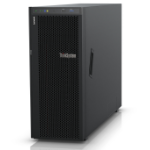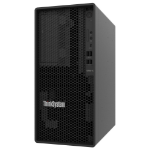Understanding the Differences Between Rack and Tower Servers


In today's data-driven business landscape, choosing the right server infrastructure is crucial. When it comes to server hardware, two primary options dominate the market: rack servers and tower servers. Both offer robust solutions for various needs, but understanding their key differences is essential for making an informed decision. This blog delves into the key distinctions between rack and tower servers, empowering businesses to select the most suitable option for their specific requirements.
Form Factor and Deployment:
Rack Servers: Designed for installation within standardised server racks, these compact and lightweight servers maximise space efficiency in data centres or server rooms. They typically slide horizontally into vertical racks, allowing for stacking multiple servers in a single cabinet.
Tower Servers: Resembling traditional desktop computers, tower servers stand upright on the floor or desk. They are often larger than rack servers and are well-suited for smaller-scale deployments or environments lacking dedicated server space.
Performance and Scalability:
Rack Servers: Generally designed for high-performance computing and demanding workloads, rack servers often offer more powerful processors, larger memory capacities, and greater storage options compared to tower servers. They are well-suited for scaling up server infrastructure as business needs evolve, allowing for the addition of more servers within the rack.
Tower Servers: While not as powerful as their rack-mounted counterparts, tower servers offer sufficient performance for many typical business applications, such as file sharing, email hosting, and basic web hosting. They are a cost-effective option for smaller businesses or environments with limited space and moderate computing requirements.
Cooling and Noise Considerations:
Rack Servers: Due to their compact form factor and potential high-density deployment within racks, rack servers often require dedicated cooling systems to manage heat dissipation. This can involve additional fans within the server or specialised cooling units within the data centre.
Tower Servers: Typically equipped with internal fans, tower servers are generally quieter than rack servers due to their larger size and better ventilation. This can be a significant advantage for environments where noise levels are a concern, such as small offices or co-working spaces.
Choosing the Right Server: A Matter of Needs and Constraints
Ultimately, the choice between a rack server and a tower server depends on your specific business needs and constraints. Consider factors like:
Available space: Do you have dedicated server space with server racks, or are you limited to floor or desk space?
Performance requirements: Do you need a high-performance server for demanding applications, or is a basic server sufficient for your needs?
Scalability requirements: Do you anticipate needing to add more servers in the future?
Budgetary constraints: How much are you willing to invest in your server infrastructure?
By carefully evaluating these factors alongside the key differences between rack and tower servers, you can make an informed decision and select the server solution that best aligns with your business's current and future requirements.
Ready to choose the right server for your business? Explore our diverse range of rack and tower servers available and even consult with our IT professionals to ensure the chosen option aligns perfectly with your specific needs and budget! Get in contact with us here.
Form Factor and Deployment:
Rack Servers: Designed for installation within standardised server racks, these compact and lightweight servers maximise space efficiency in data centres or server rooms. They typically slide horizontally into vertical racks, allowing for stacking multiple servers in a single cabinet.
Tower Servers: Resembling traditional desktop computers, tower servers stand upright on the floor or desk. They are often larger than rack servers and are well-suited for smaller-scale deployments or environments lacking dedicated server space.
Performance and Scalability:
Rack Servers: Generally designed for high-performance computing and demanding workloads, rack servers often offer more powerful processors, larger memory capacities, and greater storage options compared to tower servers. They are well-suited for scaling up server infrastructure as business needs evolve, allowing for the addition of more servers within the rack.
Tower Servers: While not as powerful as their rack-mounted counterparts, tower servers offer sufficient performance for many typical business applications, such as file sharing, email hosting, and basic web hosting. They are a cost-effective option for smaller businesses or environments with limited space and moderate computing requirements.
Cooling and Noise Considerations:
Rack Servers: Due to their compact form factor and potential high-density deployment within racks, rack servers often require dedicated cooling systems to manage heat dissipation. This can involve additional fans within the server or specialised cooling units within the data centre.
Tower Servers: Typically equipped with internal fans, tower servers are generally quieter than rack servers due to their larger size and better ventilation. This can be a significant advantage for environments where noise levels are a concern, such as small offices or co-working spaces.
Choosing the Right Server: A Matter of Needs and Constraints
Ultimately, the choice between a rack server and a tower server depends on your specific business needs and constraints. Consider factors like:
Available space: Do you have dedicated server space with server racks, or are you limited to floor or desk space?
Performance requirements: Do you need a high-performance server for demanding applications, or is a basic server sufficient for your needs?
Scalability requirements: Do you anticipate needing to add more servers in the future?
Budgetary constraints: How much are you willing to invest in your server infrastructure?
By carefully evaluating these factors alongside the key differences between rack and tower servers, you can make an informed decision and select the server solution that best aligns with your business's current and future requirements.
Ready to choose the right server for your business? Explore our diverse range of rack and tower servers available and even consult with our IT professionals to ensure the chosen option aligns perfectly with your specific needs and budget! Get in contact with us here.


